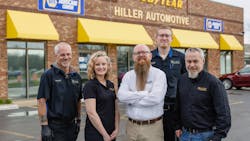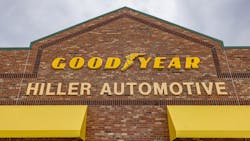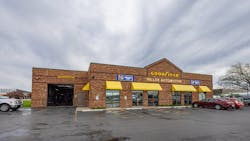When shops take a closer look at their financial figures, many discover that their net profits fall short of their expectations. This revelation prompts a host of inquiries about potential areas for improvement. Shop owners begin to seek ways to enhance their metrics and boost their bottom line. However, this endeavor is often challenging, as they strive to maximize profits without implementing drastic structural changes within their businesses.
Monitoring and Improving your KPIs
One of the first steps that shop owners can take is to understand and manage their KPIs. As a shop owner, taking the time to monitor the statistics weekly, at the least, will help you identify areas of potential growth while correcting metrics that may not be up to par. Some of the most important KPIs are those that reflect the efficiency of technicians, the overall efficiency of the shop, and the effective labor rate.
This may sound like it’s a technique for control, but it’s not. Hiller Automotive is a three-store shop with locations in Peoria, Pekin, and Springfield, Illinois. At Hiller, they take a step back and assign specific employees to key roles to enhance our operational efficiency. “We have designated a dedicated a technician alongside a specialized technician focused on all engine and transmission repairs,” says Jimmy Jones, general manager of the Peoria location. By utilizing the expertise of each individual technician and allowing them to perform the work that they are best suited for, there’s an increase in the effective labor rate.
The assignment process has to start with hiring, and finding an overall well-balanced staff that can tackle all the different types of work that comes through the doors in the most efficient way possible. Employees at Hiller are paid competitively on an hourly plus commission pay structure, allowing them to hire the best and most well-rounded technicians for their needs.
The Net Profit
Understanding net profit as both a numerical figure and a percentage of total sales over a specified period—after deducting all operational costs, including salaries—is essential for any automotive shop. This calculation enables a shop to assess its net profit situation in relation to its sales. It's important to note that net profits can differ significantly between shops, largely due to variations in size and scale of operations. Generally, a healthy net profit margin ranges between 10% and 20%.
For many automotive shops, increasing net profit is a primary goal. The traditional method involves determining the desired net profit margin as a percentage, translating that into the target monetary net profit, and subsequently calculating the sales necessary to meet this objective. By taking the average repair order (ARO) and dividing the required sales increase by this figure, one can ascertain the number of additional repair orders needed to achieve the desired net profit enhancement.
Moreover, this figure also translates into the additional vehicles the shop must service. By further dividing this number by the operating period—whether in months, weeks, or days—shops can clearly identify the additional volume of cars necessary to elevate their net profit.
Increasing net profit isn't straightforward for most shops, as boosting sales directly typically demands additional expenses. You'll need more technicians and more space, not to mention expanded marketing efforts. These represent tangible financial metrics that inevitably drive up your costs.
This is where an in-depth analysis of the pricing structure of labor hours and parts can help shops reach the desired net profit goals. Sometimes a small increment to the labor rate can help profitability without marginalizing customers.
The Importance of the Shop Management System
The market currently offers a wide range of shop management software for both front and back-of-the-house. Fully utilizing the capabilities of your shop management system can allow you to generate larger AROs, bigger tickets, and strengthen your relationship with existing customers. At a moment in time when car counts are declining, making the most out of every car that comes into your shop, without pressuring sales, can affect your bottom line.
These systems are incredibly valuable because they eliminate missed opportunities through human error. “The system reads my declined services. When customer X schedules or changes an appointment, the system remembers that we previously recommended a certain service that she declined. Then, when she calls to schedule again, the system automatically asks, ‘are you scheduling for that certain service?’” says Jones.
Structure and Transparency with the Staff
Hiller Automotive has a unique ownership and profit-sharing structure implemented by the parent company, Kingdom Autocare. “Our profit-sharing breakdown allocates funds in a balanced way. The owner retains 50% of the profits while the other 50% is distributed among our employees, covering both front and back-of-house staff. This ensures that everyone is rewarded for their contributions,” says Jones.
This business model isn’t applicable to all shops, but it does create that culture of growth mindset. When all employees can see the profit and loss statement, it creates a special motivation. “I believe we've positioned ourselves for greater success by aligning tasks with the right skills,” says Jones.
Understanding the strengths of each employee helps them tackle their day-to-day work in a more efficient manner. Scheduling the workflow in a way that maximizes the skill level of each technician helps achieve a greater effective labor rate. “This approach has proven to enhance productivity in the shop, allowing each team member to focus on what they do best,” says Jones. As a result of these measures, the Peoria location has had almost no personnel turnover and has shown growth and profit numbers consistently.
Questioning your Parts Matrix
There are many ways across the industry of using a parts matrix. The most common understanding is that as part costs increase, their multipliers decrease, resulting in smaller percentage margins on expensive parts and larger percentages on cheaper ones.
While less expensive parts show higher percentage margins on paper, they generate fewer actual dollars compared to costlier parts. In mathematical terms, the median is where most actual profit occurs. This central band of your parts matrix should produce the dollar amount auto repair businesses need for their profit margins. By understanding and properly applying multipliers in your parts matrix, you can effectively maximize your profit margin.



